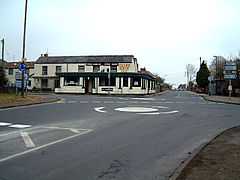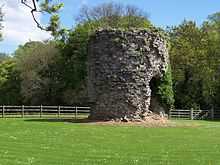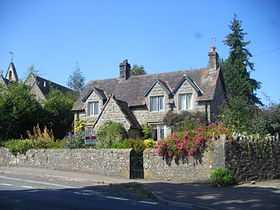Tutshill
| Tutshill | |
 Crossroads at Tutshill |
|
 Tutshill |
|
| OS grid reference | ST539946 |
|---|---|
| District | Forest of Dean |
| Shire county | Gloucestershire |
| Region | South West |
| Country | England |
| Sovereign state | United Kingdom |
| Post town | CHEPSTOW |
| Postcode district | NP16 |
| Dialling code | 01291 |
| Police | Gloucestershire |
| Fire | Gloucestershire |
| Ambulance | South Western |
| EU Parliament | South West England |
|
|
Coordinates: 51°38′54″N 2°39′56″W / 51.64829°N 2.66565°W
Tutshill is a small village within the parish of Tidenham in the Forest of Dean, Gloucestershire, England. It is located on the eastern bank of the River Wye, which forms the boundary with Monmouthshire at this point and which separates the village from the town of Chepstow. The village of Woodcroft adjoins Tutshill to the north, and across the A48 road to the south is the village of Sedbury.
History

The name derives from the ruined "tut", a local term for watchtower, on top of the hill overlooking the River Wye and its ancient crossing point at Castleford. and also having a distant view of the River Severn and estuary. The tower is of uncertain date, and has been suggested as either an Anglo-Norman watchtower linked to Chepstow Castle, or a later windmill. A windmill overlooking the Wye above Chapelhouse Wood is recorded in 1584.[1] It may have been later adapted as a folly, leading to a local tradition that the ruined mill had been a look-out tower.[1]
Tutshill was once common land in "Bishton tithing" to the south of Tidenham Chase.[2] The only house near the crossroads at Tutshill before the 19th century was apparently Tutshill Farm recorded from 1655.[2]
After the town of Chepstow developed and a bridge was built over the Wye, the main road between Gloucestershire and Monmouthshire followed the steep hill directly up the river bank between the bridge and Tutshill – now a footpath linking Chepstow to the Offa's Dyke Path – until a new road looping around Castleford Hill was opened in 1808.[3] This road carried traffic between the two counties until a new bridge was built at Chepstow in 1988, whereupon Tutshill was bypassed.
The expansion of Tutshill had begun by 1828 when building-plots north-east of the crossroads were sold, and by 1843 there were houses extending along the roads to the north and east with the Cross Keys Inn at the corner.[2] By 1856 Tutshill was already a minor centre with two public-houses, a shop, a post office, a solicitor's office, and a private school.[2] By this time the growing population of the Tutshill and Woodcroft area of the parish was recognized by the building of a church and a school on the road between the two hamlets. The church, dedicated to St. Luke, is a Gothic stone building comprising a nave with a bellcot at the south-eastern corner, a chancel, and a north aisle added in 1872.[4] There was another period of expansion in the late 19th century and early years of the 20th, and there was a major increase in the population in the middle years of the 20th century when new housing-estates were built.[2]
There was a railway station, Tutshill Halt, near Tutshill which was closed in 1959. [2] Today many of the residents commute to nearby cities such as Bristol, Cardiff or Gloucester.
Schools
Tutshill Church of England Primary School is located in the village and caters for children from the ages of 4 to 11.[5]
In addition, St. John's on-the-Hill is an independent co-educational day and boarding preparatory school with all-year round day nurseries and a "pre-prep" for children under the age of eight. Founded in 1923, the school is situated in grounds overlooking Chepstow Castle.[6]
J. K. Rowling

The village was the childhood home, from the age of nine in 1974, of the author J. K. Rowling. She attended Tutshill Church of England Primary School before moving on at the age of eleven to the nearby Wyedean School in Sedbury. Her childhood home, Church Cottage, a mid-19th century Gothic-style Grade II listed building designed by the architect Henry Woodyer, was put up for sale in 2011.[7][8]
The character Severus Snape in the Harry Potter books was partly based on Sylvia Morgan, a teacher at her primary school,[9] and on one of her teachers at Wyedean School, John Nettleship.[10] In the book Harry Potter and the Deathly Hallows, a passage is set in the Forest of Dean, where Harry, Hermione and Ron are camping and discover the Sword of Gryffindor where it has been hidden by Snape. Tutshill is also the home of a fictional professional Quidditch team operating within the Harry Potter universe. The Tutshill Tornados are one of thirteen fictional Quidditch teams that play in the professional Quidditch League of Britain and Ireland that was established in 1674. The team players wear sky-blue robes emblazoned with a double "T" in dark blue on the chest and back. In the early 20th century the fictional team set a British and Irish record by winning the League Cup five times in a row.[11]
References
- ↑ 1.0 1.1 Look Out Tower, Pastscape, retrieved 19 April 2013
- ↑ 2.0 2.1 2.2 2.3 2.4 2.5 Tidenham including Lancaut: Introduction, Victoria County History
- ↑ Ivor Waters, Turnpike Roads - the Chepstow and New Passage Turnpike Districts, 1985, ISBN 0-906134-31-5
- ↑ Tidenham including Lancaut: Churches, Victoria County History
- ↑ Tutshill Primary School website. Retrieved 16 December 2012
- ↑ St. John's on-the-Hill School website
- ↑ Steven Morris, The ultimate Harry Potter memorabilia: JK Rowling's childhood home is for sale, The Guardian, 13 July 2011. Accessed 13 July 2011
- ↑ RightMove: Church Cottage, Tutshill, Chepstow. Accessed 13 July 2011
- ↑ Connie Ann Kirk, J.K. Rowling: a biography, Greenwood Publishing Group, 2003, pp.29-32
- ↑ Article: J.K. Rowling's inspirational teacher
- ↑ "Kennilworthy Whisp" (2001). Quidditch Through the Ages. WhizzHard Books. pp. 31–46. ISBN 1-55192-454-4.
External links
| Wikimedia Commons has media related to Tutshill. |